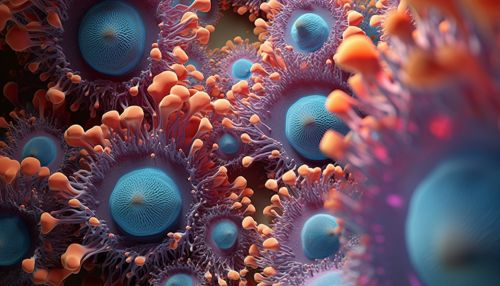Neoplasm
Definition
A neoplasm is an abnormal growth of tissue, which may be benign or malignant. It is the result of an uncontrolled proliferation of cells, often as a result of genetic mutations. Neoplasms can occur in any tissue or organ in the body and can vary greatly in their clinical presentation and severity.
Classification
Neoplasms are classified based on several factors, including their tissue of origin, their behavior (benign or malignant), and their degree of differentiation.
By Tissue of Origin
Neoplasms can be classified by the type of tissue from which they originate. For example, a carcinoma originates from epithelial tissue, which lines the body's surfaces and cavities. A sarcoma, on the other hand, originates from connective tissue, such as bone, muscle, or fat.
By Behavior
Neoplasms can also be classified as benign or malignant. Benign neoplasms are non-cancerous growths that do not invade surrounding tissues or spread to other parts of the body. Malignant neoplasms, or cancers, have the ability to invade nearby tissues and spread, or metastasize, to other parts of the body.
By Degree of Differentiation
The degree of differentiation refers to how much the neoplastic cells resemble the normal cells from which they originated. Well-differentiated neoplasms closely resemble the normal tissue, while poorly differentiated or undifferentiated neoplasms do not resemble the normal tissue and tend to behave more aggressively.
Pathogenesis
The pathogenesis of neoplasms involves a series of genetic mutations that lead to uncontrolled cell proliferation. These mutations can be caused by various factors, including exposure to carcinogens, such as tobacco smoke or radiation, inherited genetic mutations, and certain viral infections.


Diagnosis
The diagnosis of a neoplasm often involves a combination of physical examination, imaging studies, and laboratory tests. A biopsy, or tissue sample, of the suspected neoplasm is often obtained for histological examination under a microscope. This can help determine the type of neoplasm and its degree of differentiation.
Treatment
The treatment of neoplasms depends on the type and stage of the neoplasm, as well as the patient's overall health. Treatment options may include surgery, radiation therapy, chemotherapy, immunotherapy, or a combination of these. In some cases, if the neoplasm is benign and not causing symptoms, watchful waiting may be an option.
Prognosis
The prognosis for individuals with a neoplasm varies widely and depends on many factors, including the type and stage of the neoplasm, the patient's overall health, and the effectiveness of the treatment.
Epidemiology
Neoplasms are a common cause of morbidity and mortality worldwide. The incidence and types of neoplasms vary by geographic region, largely due to differences in exposure to risk factors.
